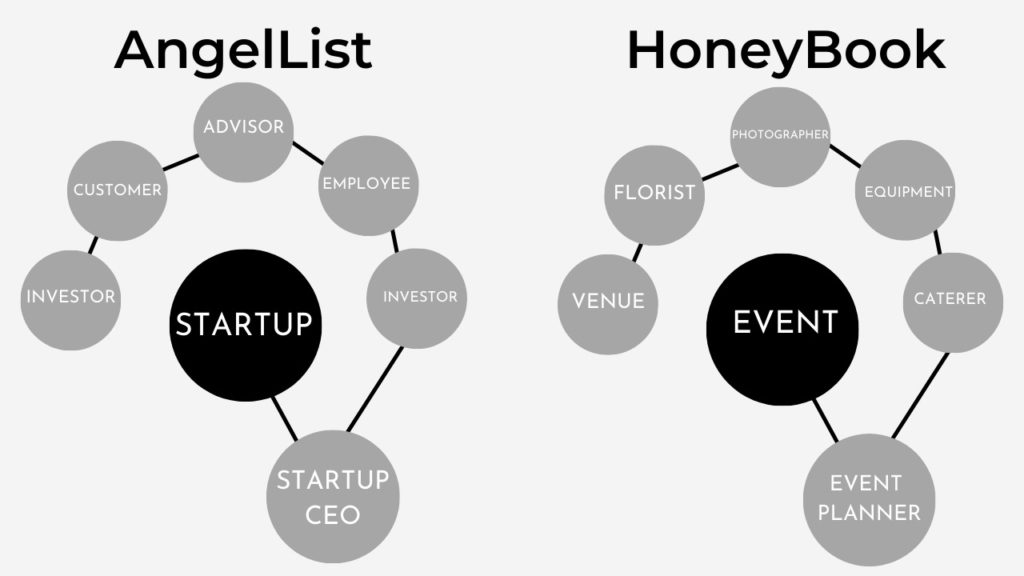7 Attributes of a Successful Market Network
- More complicated services are targeted via market networks.
- People are important.
- Collaboration occurs in the context of a project.
- They have distinct profiles of the individuals involved.
- They aid in the development of long-term connections.
- Referrals are plentiful.
- They boost transaction speed and satisfaction.
The Last Ten Years Have Been Social Networks. The Next 10 Will Be Market Networks.
The Next Ten Years Will Be About "Market Networks"
Market networks will give rise to a new breed of unicorn enterprises, creating an impact on the way millions of service workers work and earn a living.
What is a Market Network
Consider the social media sites Facebook, Twitter, Goodreads, and LinkedIn.
What makes Market networks unique is that they:
- Combine the most important aspects of both networks and markets.
- Use SaaS workflow tools to concentrate the action on long-term initiatives rather than one-time transactions.
- Promote the service provider as a unique individual who can assist in the development of long-term partnerships.
Market networks are also distinct in terms of monetization. They blend the defensibility and scalability of direct networks such as LinkedIn and Facebook with the lucrative revenue models of SaaS or marketplace firms.

Take HoneyBook, a market network for the events industry, as an example.
On HoneyBook.com, an event organiser creates a profile. On the Internet, that profile serves as his professional home. He sends self-branded proposals to clients and signs contracts digitally using the HoneyBook SaaS workflow.
He then connects with other specialists he knows, such as florists and photographers, to complete the job. They also have HoneyBook profiles, where they can work together to service a client, send each other offers, sign contracts, and get paid by each other.

This pattern of many-to-many transactions is crucial. HoneyBook is an N-sided marketplace, which means that transactions take place in a 360-degree pattern, similar to a network, but they come here to transact. HoneyBook is thus both a marketplace and a network.
A market network frequently begins by giving a professional a SaaS solution that allows them to complete a vital task. That same SaaS application then allows the professional to engage more effectively with their existing offline network, whether it is clients, other professionals, or both. For years, many members of these professional networks have communicated with one another via fax, checks, overnight deliveries, and phone calls.
A market network makes it much easier for professionals to run their firms and for clients to receive better service by putting these connections and transactions into the software.
We’ve seen this before
AngelList is a market network as well. I’m not sure if it was the first, but Naval Ravikant and Babak Nivi deserve a lot of credit for being the first to introduce the model in 2010.
The trend is similar on AngelList. The startup’s CEO establishes her own profile before encouraging her network of investors, employees, advisors, and customers to do the same. The CEO can then use the AngelList SaaS workflow to complete some or all of her fundraising papers, and everyone in the network can share deals, hire workers, and discover consumers in a 360-degree pattern.
A third good example is Houzz. Houzz connects homeowners with home improvement professionals as well as products for their homes. They have a product that resembles a market network in many ways. Houzz raised $165 million in its most recent round (update: since the original publication of this storey, Houzz has secured a $400 million investment, putting the company at $4 billion). They also bought Ivy, an NFX-backed firm that gives them access to the whole market network of interior designers).
The residential real estate brokerage industry in Cincinnati follows the same pattern as DotLoop. In August 2015, Zillow Group purchased DotLoop for $108 million as part of the company’s transition to a market network.
The market network pattern may be seen on AngelList, DotLoop, Houzz, and HoneyBook.
7 Attributes of a Successful Market Network

1. More complicated services are targeted via market networks.
The tech industry has been infatuated with on-demand labour marketplaces for rapid transactions of simple services for the past decade. Uber, Lyft, Mechanical Turk, Thumbtack, DoorDash, and a slew of other companies have made it simple to buy simple services whose quality can be rated objectively. Their prosperity was built on the commodification of individuals on both sides of the market.
However, the most valuable services, such as event planning and home renovations, are neither straightforward nor objectively assessed. They’re more involved and have a longer time horizon. These are the kinds of things that market networks are made for.
2. People are important.
Each client is unique when it comes to difficult services, and the specialist they are assigned to matters. Would you trust just anyone with your wedding? Are you planning a house renovation? Unlike Lyft or Uber, the people on both sides of those equations are not replaceable.
To the transaction, each participant offers their own set of perspectives, expertise, and connections. A market network is built to recognise this as a fundamental tenet and to supply a solution.
3. Collaboration occurs in the context of a project.
Multiple professionals work among themselves—and with a client—over time to provide the most sophisticated services.
4. They have distinct profiles of the individuals involved.
People are more likely to return and interact here if the profiles are appealing and contain information specific to their context. It better captures a portion of their identity than anything else on the internet.
5. They aid in the development of long-term connections.
Market networks consolidate and improve the value of a lifetime’s worth of professional contacts. For years, social media sites such as LinkedIn and Facebook have aided in the development of long-term partnerships. Market networks, on the other hand, had never been used for trade or transactions before.
6. Referrals are plentiful.
Referrals are gold in many businesses, for both the client and the service provider. Referrals are made easier and more frequent with the market network software.
7. They boost transaction speed and satisfaction.
The market network boosts transaction velocity for everyone by placing the network of professionals and clients into the software. It improves proposal closing rates and accelerates payment. The programme also improves client satisfaction, decreases confusion, and improves the aesthetics of the job.
The Last Ten Years Have Been Social Networks. The Next 10 Will Be Market Networks.
We had communication networks such as telephones and email at first. Then there were social media platforms such as Facebook and LinkedIn. Market networks such as HoneyBook, AngelList, DotLoop, and Houzz are now available.
Every industry where professionals are not interchangeable, such as law, travel, residential real estate, commercial real estate, media production, architecture, investment banking, interior design, personal finance, commercial construction, residential construction, consulting, and more, could benefit from a market network.
The characteristics that make each market network function in each vertical may vary, but the concepts will remain the same. Eventually, practically all independent professionals and their clients will do business through their industry’s market network. We’re only at the start of it right now.
More entrepreneurs should aim to develop these firms, in my opinion. It’s now or never. They’re difficult to do right, but the payback might be enormous.

